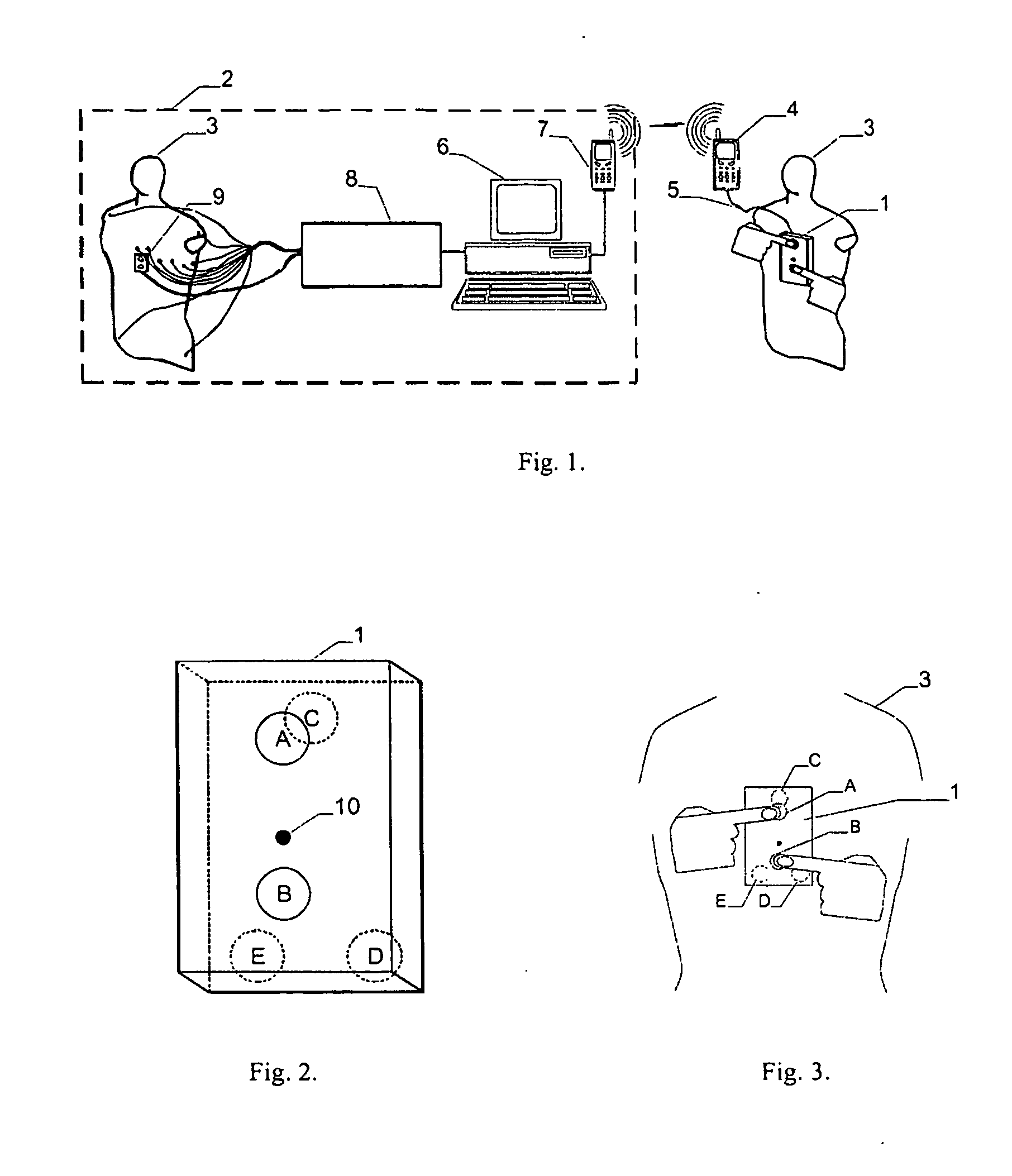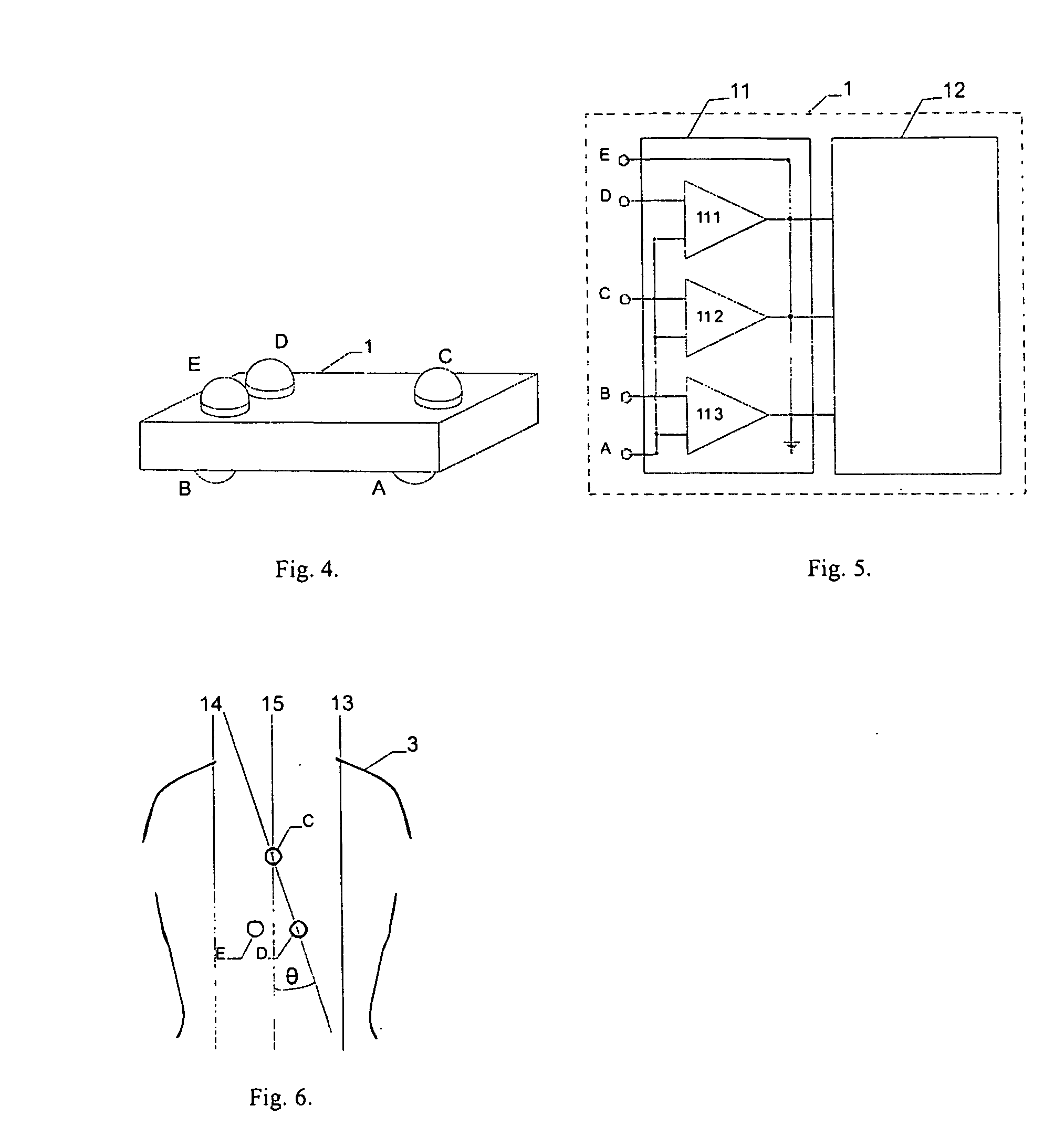[0010] The invention presents the method and device for
cordless recording, telecommunication transmission, and processing of three special ECG leads. The recording of three special ECG leads is performed with the mobile device with strictly defined arrangement of integrated electrodes and the way of recording, which, after the transmission to a remote PC computer, enables the precise reconstruction of all 12 signals of standard ECG leads. In this way, the simplicity of use of the device with integrated electrodes is combined with high recording accuracy, until now possible only with the devices using cables for recording. The
system consists of the stationary diagnostic callibration center and the mobile ECG device with integrated electrodes. The diagnostic callibration center comprises a PC computer with the corresponding
software, connected to a
cellular telephone and a callibration ECG device with 14 electrodes. The calibration device is used for simultaneous recording of patient's 12 standard and three special ECG leads. The recording of special leads is performed in a way which a patient will use himself while recording with the mobile ECG device with integrated electrodes. On the basis of the recorded data the
transformation matrix of a patient is calculated and stored into a
database. The obtained matrix is used for calculation of 12 standard ECG leads every time the patient sends, via telephone, the recording of three special leads taken by himself using the mobile ECG device with integrated electrodes.
[0016] Finally, having in mind the model errors (a) and the
transformation matrix calculation errors (b), two requirements are imposed concerning the arrangement of the integrated electrodes for special leads recording, in order to minimize the
total error. The first one is to position the electrodes of the special leads as far as possible from the heart; the second one is to arrange the electrodes in such a way that the vectors of recording points' positions are close to orthogonal as much as possible. Both said conditions cannot be fulfilled simultaneously when recording of the special leads should be performed with the mobile ECG device with integrated electrodes, i.e. without cables. The solution we offer presents the optimal configuration fulfilling the said requirements to the furthest extent within the limitations imposed by the use of the mobile ECG device with integrated electrodes. The mobile ECG device is designed in such a way that two integrated electrodes could be touched with the fingers of the left and right hand, while two electrodes are simultaneously in contact with the patient's chest. The patient's hands are used as flexible elements for moving two recording points away from the heart (as the source of the electrical activity), using the
electrode in contact with a finger of the right hand as the reference point for the recording of all three special leads. The electrodes in electrical contact with the patient's chest are set in the precisely defined position within the limited area on the patient's chest. By arranging the electrodes positions in this way, and choosing the reference point, the optimal minimization of the model errors (a) and
transformation matrix calculation errors (b) has been achieved.
[0017] An additional problem in
signal recording of special as well as of standard ECG leads is the effect of the
base line wandering of the recorded signals. The problem occurs during the recording of ECG signals with all kinds of ECG devices, but is more prominent with mobile ECG devices due to the more difficult recording conditions, especially with the devices intended for patient's recording of his own ECG. When systems which obtain standard ECG leads by the reconstruction of recorded special leads are concerned, the
elimination of the
base line wandering problem during recording of special leads is extremely important for the proper functioning of the
system. This invention establishes the control of the
base line wandering during recording of special leads with a mobile ECG device with integrated electrodes by the means of
digital control module which controls and manages the process of recording automatically. From the moment of putting the device into the recording position untill the moment when the base line of a
signal fits into the previously specified range, a characteristic sound
signal is being emitted. During the next period defined by the signal relaxation time, another characteristic sound signal is being emitted, informing a patient that the recording will start soon. The recording itself is indicated by the third characteristic sound signal. If the significant base line wandering occurs in any phase of the procedure, the procedure will be repeated from the beginning. Doing so, the patient is enabled to send the high-quality recording of special leads, which makes possible the accurate reconstruction of standard ECG leads.
[0018] The arrangement of integrated electrodes described above, their positioning, the way of recording, and described
system for eliminating the base line wandering of recorded signals minimize the errors in the reconstruction of standard ECG leads, making the accuracy of recording similar to the standard ECG devices. Thus, the simplicity in use of the device with integrated electrodes is combined with high precision of the devices using cables for recording.
 Login to View More
Login to View More  Login to View More
Login to View More 


